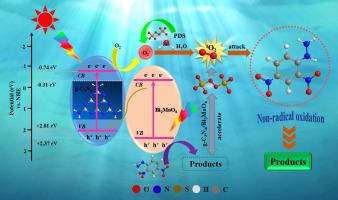Journal of Colloid and Interface Science ( IF 9.9 ) Pub Date : 2021-09-02 , DOI: 10.1016/j.jcis.2021.08.198 Xing Zhang 1 , Suhang Chen 1 , Xiaoyan Lian 1 , Shuai Dong 1 , Hui Li 2 , Kangzhen Xu 1

|
Persulfate-assisted photocatalysis technology is considered to be a promising method for the rapid and efficient degradation of organic pollutants in water environment remediation. In this study, a novel g-C3N4/Bi2MoO6/PDS (CN/BMO/PDS) system is constructed and applied in 2,4-dinitrophenylhydrazine (2,4-DPH) degradation under visible light irradiation. Compared with the CN/BMO system, the degradation rate of 2,4-DPH is significantly improved from 59.7% to 90.2% within 60 min in the combined CN/BMO/PDS system. The enhanced performance can be attributed to the superior synergetic effects of CN/BMO, PDS and visible light irradiation. More importantly, singlet oxygen (1O2) is determined as the main reactive species based on the radical scavenging experiments and electron paramagnetic resonance (EPR), which indicates that the combined system can achieve non-radical oxidative degradation of pollutants, instead of the traditional radical oxidation process. In addition, the active sites of the reaction during the non-radical 1O2 oxidation are calculated by density functional theory (DFT), and the stability and reusability of catalyst are also investigated. In brief, the CN/BMO/PDS system has great application potential for removing organic pollutants from wastewater.
中文翻译:

g-C3N4/Bi2MoO6纳米复合材料有效活化过二硫酸盐,通过非自由基主导氧化过程增强有机污染物降解
过硫酸盐辅助光催化技术被认为是一种在水环境修复中快速高效降解有机污染物的有前景的方法。本研究构建了一种新型gC 3 N 4 /Bi 2 MoO 6 /PDS(CN/BMO/PDS)体系,并将其应用于可见光下2,4-二硝基苯肼(2,4-DPH)的降解。与CN/BMO系统相比,在CN/BMO/PDS组合系统中,2,4-DPH的降解率在60分钟内从59.7%显着提高到90.2%。增强的性能可归因于 CN/BMO、PDS 和可见光照射的卓越协同效应。更重要的是,单线态氧 ( 1 O 2) 被确定为基于自由基清除实验和电子顺磁共振 (EPR) 的主要反应物种,这表明组合系统可以实现污染物的非自由基氧化降解,而不是传统的自由基氧化过程。此外,通过密度泛函理论(DFT)计算了非自由基1 O 2氧化反应的活性位点,并研究了催化剂的稳定性和可重复使用性。总之,CN/BMO/PDS系统在去除废水中的有机污染物方面具有巨大的应用潜力。


























 京公网安备 11010802027423号
京公网安备 11010802027423号